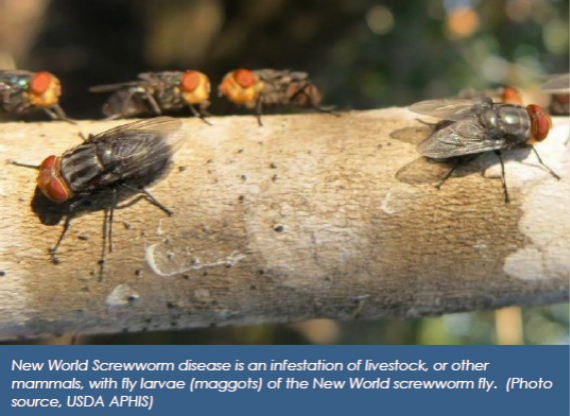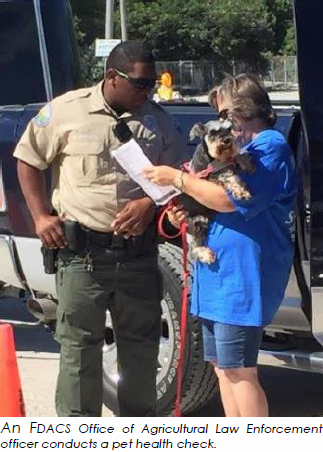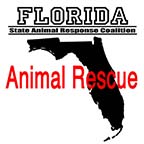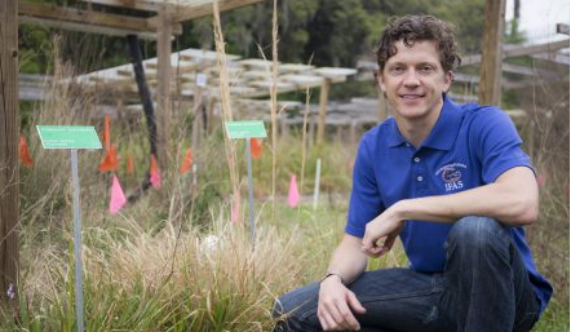
Vol. 13, No. 4, April 2017 |
 Printer-Friendly PDF Version Printer-Friendly PDF Version |

With No Screwworms Found in Months, Animal Health Checkpoint in Monroe County to Close
After more than five months of aggressive response efforts and no new screwworm infestations, the Florida Department of Agriculture and Consumer Services last month began winding down its response to the New World screwworm infestation in Monroe County. No new cases have been found since January 10th.
Following established protocols, the animal quarantine for Monroe County was lifted, and the Animal Health Check Point in Key Largo was closed on March 18th.
The United States Department of Agriculture's Animal and Plant Health Inspection Service confirmed the presence of New World screwworm in Key deer from a wildlife refuge in Big Pine Key, Florida, in late September 2016. This was the first local infestation in the United States in more than 30 years.
According to the USDA, during the past century the presence of New World screwworm cost the U.S. livestock industry an average of $20 million annually.
The adult screwworm fly is about the size of a common housefly (or slightly larger), with orange eyes, metallic blue or green body, and three dark stripes along the back. The term screwworm refers to the screw-like shape of the larvae that feed on the host animal.
 In response to this infestation, Florida Commissioner of Agriculture Adam Putnam declared an agricultural state of emergency in Monroe County, Florida. In addition, the department established an Animal Health Check Zone from mile marker 91 south. Animals traveling north were given health checks at an interdiction station located at mile marker 106 to ensure that they do not have screwworm.
In response to this infestation, Florida Commissioner of Agriculture Adam Putnam declared an agricultural state of emergency in Monroe County, Florida. In addition, the department established an Animal Health Check Zone from mile marker 91 south. Animals traveling north were given health checks at an interdiction station located at mile marker 106 to ensure that they do not have screwworm.
Since the Animal Health Check Point was established at the onset of the investigation, inspectors have checked more than 16,000 animals with no detections of screwworm.
Residents who have warm-blooded animals (pets, livestock, etc.) should continue to watch their animals carefully and report any potential cases to 1-800-HELP-FLA (1-800-435-7352).
For more information on the response by FDACS, please visit the Screwworm site at: http://FreshFromFlorida.com/screwworm.

Source: https://www.aphis.usda.gov/aphis/maps/animal-health/screwworm-mapping
FDA, Federal Partners Issue New Food Safety Analytics Strategic Plan
The U.S. Food and Drug Administration (FDA), Centers for Disease Control and Prevention (CDC), and the U.S. Department of Agriculture’s (USDA) Food Safety and Inspection Service (FSIS) have issued a new Strategic Plan for 2017-2021 as part of the Inter-agency Food Safety Analytics Collaboration (IFSAC).
IFSAC was created in 2011 to improve coordination of federal food safety analytic efforts and address cross-cutting priorities for food safety data collection, analysis, and use. Its projects and studies aim to identify foods that are important sources of human illness. IFSAC focuses analytic efforts on four priority pathogens: Salmonella, Escherichia coli (E. coli) O157:H7, Listeria monocytogenes (Lm), and Campylobacter. CDC estimates these four pathogens combined cause 1.9 million cases of foodborne illness in the United States each year.
Under the new strategic plan, IFSAC will focus on continuing to improve estimates of the sources of foodborne illnesses and developing methods to estimate how these sources change over time. The three goals of the new strategic plan are to improve the use and quality of new and existing data sources; improve analytic methods and models; and enhance communication about IFSAC progress.
The strategic plan outlines key objectives to achieve those goals, including:
- Enhance the collection and quality of relevant source data;
- Enhance the use of existing regulatory and foodborne illness surveillance data;
- Incorporate genomic data and other novel data sources;
- Explore ways to address key gaps in data quality, methods and models;
- Develop new analytic approaches and models to maximize use of existing data;
- Expand the availability of technical and scientific expertise through collaboration with internal and external partners;
- Enhance relationships and engagement with internal and external groups;
- Improve the synthesis, interpretation and dissemination of analytical findings for multiple audiences.
The plan also highlights accomplishments from IFSAC’s first five years and the group’s intent to continue engaging with stakeholders on future work. For more information on IFSAC, please visit the collaboration’s website.

UF/IFAS Shares in $2.45 Million to Research Tickborne Disease Risk

Plant ecologist Luke Flory. Photo by Amy Stuart
To protect personnel on Southeastern military installations from tickborne diseases, a federal program has awarded a five-year, $2.45 million grant to a team of researchers with the University of Florida Institute of Food and Agricultural Sciences and other institutions. The grant was provided by the federal Strategic Environmental Research and Development Program, an initiative supported by the U.S. Department of Defense, Department of Energy, and the Environmental Protection Agency.
The scientists will determine how tick populations are affected by invasive plants, fire, and the availability of host animals in specific locations; this information will help the team assess tickborne disease risk under future climate conditions.
Portions of the project based at UF/IFAS will receive more than $700,000 in funding, said Jack Payne, UF senior vice president for agriculture and natural resources. “This project requires an interdisciplinary approach to account for all of the relevant ecological factors that influence the risk of people being exposed to tickborne diseases,” Payne said. “An ideal team of subject-matter experts has come together here, and I’m proud that UF/IFAS is involved.”
Participating faculty represent UF/IFAS, the University of Illinois at Urbana-Champaign and Boston University, Payne said. Field studies will take place on more than a dozen U.S. Department of Defense properties where the lone star tick is found, including sites in six states where the tick co-exists with an invasive plant known as cogongrass — Alabama, Florida, Georgia, Louisiana, Mississippi and South Carolina.
For more information, visit https://news.ifas.ufl.edu/2017/03/ufifas-shares-in-2-45-million-to-research-tickborne-disease-risk/#more-11382.
